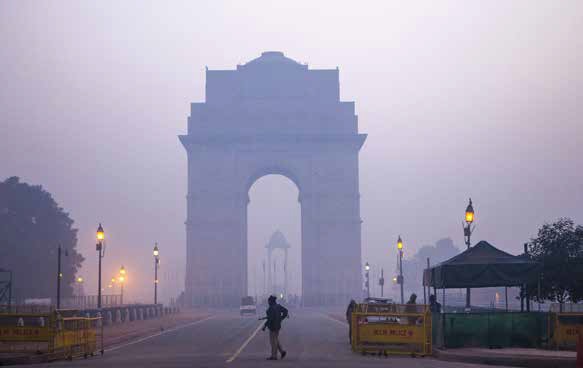
Pollution levels in Delhi usually peak between the end of October and the first half of November. The time, signifying the arrival of winter, is accompanied by a drop in temperature, which also aids the accumulation of pollutants in the atmosphere. On September 12, the Delhi government held an environmental expert meet with experts from 32 organisations and other stakeholders to discuss the winter action plan to fight air pollution.
The meeting saw participation from Delhi Pollution Control Committee (DPCC), UNEP, Centre for Science & Environment (CSE), IIT -Kanpur, Clean Air Asia and the Environment department among others.
Following the meeting, Delhi environment minister Gopal Rai announced that the Delhi government is considering using cloud seeding technology to create artificial rain in an effort to reduce air pollution in the Capital during winter.
The idea of using artificial rain to mitigate air pollution was put forward by a team of experts from IIT-Kanpur.
Concept of cloud seeding
“Cloud seeding refers to the process of spreading either dry ice or more commonly, silver iodide aerosols, into the upper part of clouds to stimulate the precipitation process and form rain,” explained Manindra Agrawal, professor of IIT-Kanpur, who headed the team which conducted the experiment to check the feasibility of cloud seeding.
In an exclusive interview to Patriot, Agrawal said, “If clouds are present and have the required moisture content, artificial rain through the process of cloud seeding is feasible.”
Delhi has the required weather conditions during winters, he added.
The idea of artificial rain is still in its infancy and requires flight clearance from DGCA and other authorities for security purposes. The estimated cost for such artificial rain would be around Rs 1 lakh per square km, he added.
Feasibility of artificial rain
If implemented, this would be the first such step in India to combat air pollution.
“Madhya Pradesh and Karnataka have experimented with cloud seeding earlier. But those were to deal with droughts. This would be the first case of cloud seeding in India to fight air pollution,” Agrawal said.
Artificial rain is commonly used in China to deal with severe pollution levels, he added.
Cloud seeding was among the many suggestions put forward by experts to combat air pollution.
During the meet, 13 hotspots were also identified. The pollution hotspots in Delhi are Anand Vihar, Wazirabad, Vivek Vihar, Wazirpur, Ashok Vihar, Dwarka, Jahangirpuri, Rohini, Bawana, Narela, Mundka, Punjabi Bagh, RK Puram and Okhla Phase 2.
All the departments concerned have been asked to submit a separate Winter Action Plan for these 13 hotspots by September 25, 2023.
Improved air quality
Aam Aadmi Party (AAP) has time and again claimed how air pollution has reduced in Delhi in recent years.
The environment minister reiterated after the expert meeting, “In the last nine years, PM 10 pollution level has come down by over 42%, while PM 2.5 level has dropped by 46%.”
However, the recently released Air Quality Life Index (AQLI) report for 2023 by the University of Chicago indexes how air pollution continues to impact the life of Delhiites. The report stated air pollution shortens the lives of the residents of Delhi by around 11.9 years.
AQLI measures the impact of particulate pollution on life expectancy. Delhi’s annual average PM2.5 level in 2021 was found to be 126.5 µg/m3, which is 25 times more than the World Health Organisation (WHO) guideline of 5 µg/m3, according to the report.
In 2020, this figure was found to be a little lower at 107 µg/m3.
“From what we’ve seen lately there is a reversal pattern of air quality which is very promising. However, I think more work still needs to be done,” said Sumi Mehta, CEO of Vital Strategy, a leading think tank working on air pollution.
Delhi has many leading sources of air pollution like traffic, construction, pollution which is coming into the city from beyond the administrative boundaries, open waste running etc.
“Though we have made progress, we still need to accelerate monitoring and efforts to mitigate the impact of air pollution,” she added when asked whether the situation has improved over the last few years.
Commenting on the progress and improvement, she further added, “we have an ambitious aim of about 40% improvement in air quality by 2025-26 across the non-attainment cities (122 cities with high pollution levels). If we are able to achieve this, it will kind of buy back around over two years of life expectancy.
Air Quality Tracker Initiative report (2023) stated, “Recent winters show about 20% improvement in seasonal air quality compared to winters of 2015-18, but progress seems to have stagnated since the pandemic.”
It adds that Delhi’s seasonal air quality for winter (Oct 1 to Feb 28) used to hover around 180-190 µg/m3 before pandemic and for the last three winters it has come down and remained stagnant at 150-160 µg/m3.
The poet-filmmaker reflects on fate, casting battles and the revival of a long-delayed dream
Delhi Police put multi-layered security and traffic arrangements in place at Arun Jaitley Stadium ahead…
A toddler was charred to death and his sister injured when a fire broke out…
Police form multiple teams, scan CCTV footage as probe points to possible old enmity behind…
Accused in a fatal 2014 neighbourhood dispute over water supply was arrested from Jhajjar after…
Tribunal holds car driver negligent in fatal 2022 crash on Dwarka Expressway, directs insurer to…